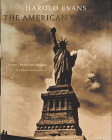
The American Century
The American Century Harold Evans Jonathan Cape London 1998 £40.00 0224052179
Merchandise Links UK Edition: Amazon.co.uk
|
In Harold Evans’s preface to his epic survey of the USA’s second century of existence, he writes of the Kodak camera’s arrival in 1889 (which year the book takes as its starting point) as ‘giving the amateur snapper equality of opportunity with the professional photographer…I like to think of the first Kodak…as a metaphor for America’s dedication to making all men free and equal.’
According to the most recent Amnesty International Annual Report, "…blacks make up just 12 percent of the USA’s population, but 42 percent of the nation’s condemned prisoners. In early 1998, of the 26 people under federal sentences of death (military and civilian), only five prisoners were white. More than 350 prisoners have been executed since 1990. Some were children when the crimes were committed: some were severely mentally impaired. Another 3,300 people are on death row, put there by a system whose application of the death penalty is arbitrary and subject to racial and class bias." America’s dedication to making all men free and equal can be disputed even in 1998 – and for most of the century Evans writes about, human rights abuses have been the norm, equality has been no more than a dream for the non-white, non-heterosexual, non-male American citizen. And then there are two of the century’s defining war crimes: the bombings of Hiroshima and Nagasaki. Evans touches on many of these issues, presenting the bald facts of injustices done by America and its politicians in the name of freedom and democracy, but remains convinced that despite these routine human rights abuses, "in the American adventure all is possible while freedom lives".
As an illustrated history of the individuals who have shaped America’s politics, The American Century is impressive. Gail Buckland’s photographic research is meticulous, the images stunning and used to excellent effect; the historical detail is often startling, the snapshot portraits of the people who have formed American domestic and foreign policy compelling. But the broader moral perspective and philosophical depth one might have hoped for is missing. There is more critical insight into the last hundred years of American history in a single paragraph by Chomsky than you’ll find in the seven-hundred-odd pages of Evans’s paean to his newly adopted homeland. Despite this, The American Century is worth buying – if only for the pictures.
Reviewed by Jennifer Merk
